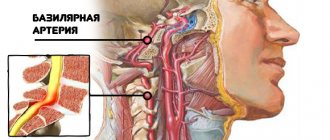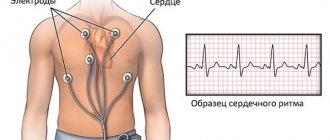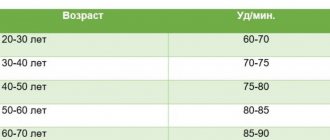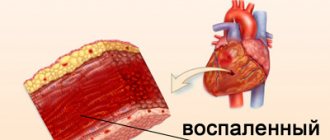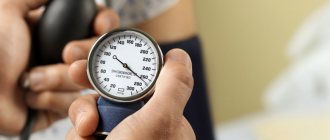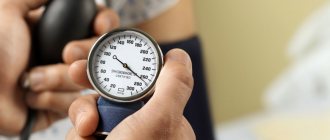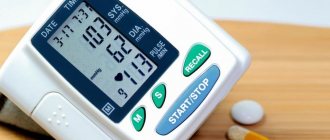- Physiological and pathological bradycardia
- What happens in the body when the heart rate slows down?
- Varieties
- Why do different types of bradycardia develop?
- Low heart rate in children: causes and consequences
- Symptoms of low heart rate
- Diagnostics
- What to do if your heart rate is low
- Surgical treatment
A condition in which the heart rate slows down is called bradycardia. They talk about it if the frequency of beats per minute is reduced to 60 or less. In some cases, this is caused by physiological reasons, but most often low pulse occurs in people with various pathologies. Heart rate (heart rate) decreases in cardiac diseases, poisoning, central nervous system diseases, and overdose of certain medications.
Physiological and pathological bradycardia
Low heart rate as a physiological phenomenon is typical for professional athletes. Due to constant intense training, the body gets used to increased stress, which affects autonomic regulation. The heart rate naturally slows down in a sleeping person. When the body is at rest, the pulse becomes low and blood pressure decreases. This is the norm. After waking up, when a person begins to engage in vigorous activity, the heart rate increases.
If there is a slowing of the heart rate while awake for unknown reasons, this condition requires the attention of specialists. Most often it is caused by diseases of the cardiovascular or nervous system, endocrine disorders, and injuries. Low heart rate occurs in both adults and children.
What happens in the body when the heart rate slows down?
Heart rate decreases due to malfunction of the sinus node. It is responsible for the production of electrical impulses, due to which the heart contracts at a physiological frequency. If the sinus node is malfunctioning, the signals are distributed incorrectly along the pathways. This primarily concerns the conduction of electrical impulses between the sinus node and the components of the heart muscle.
With a moderately low heart rate, a person does not notice a pronounced deterioration in well-being. If the heart rate continues to slow down, negative symptoms appear. They are caused by impaired blood supply to tissues. Together with the blood, nutrients and oxygen are supplied to the tissues, therefore, with a prolonged state of low heart rate, a person develops oxygen starvation. Oxygen starvation manifests itself as weakness, lethargy, and other signs of deterioration in health.
A pulse less than 40 beats indicates severe bradycardia. This condition is dangerous for the body due to severe circulatory disorders. The patient is advised to take medication, but in severe cases, drug therapy is not enough, and surgery is performed to install a pacemaker.
Diagnosis of SSSU
- An ECG
showing bradycardia of sinus origin with a frequency of up to 40 beats per minute during the day and less than 30 beats per minute at night may indicate sinus dysfunction. SA blockade, pauses of more than 3 seconds, tachy-bradycardia syndrome, migration of the pacemaker through the atria allow us to suspect a weakening of the pacemaker. - A more informative diagnostic method is Holter ECG monitoring
. It allows you to analyze the heart rhythm for a whole day or more, track the connection of disturbances with exercise, taking medications, and identify provoking factors. - In difficult situations, when dysfunction of the SU is not permanent, EFI
. An electrode is inserted into the patient's esophagus, with which the atria are stimulated to a frequency of 140-150 beats per minute, thereby suppressing the activity of the natural pacemaker and observing the time it takes to restore the function of the sinus node after cessation of stimulation.
EchoCG is used to detect organic myocardial pathology
(ultrasound of the heart), less often cardiac tomography.
Varieties
Low heart rate can be acute or chronic. The classification of bradycardia depending on the cause includes four types of disease:
- neurogenic;
- organic;
- medicinal;
- toxic.
Sometimes doctors do not have an exact answer to the question of why a person has a low pulse. In this case, we are talking about idiopathic bradycardia - a disease of unknown etiology. Mature and elderly people are susceptible to pathology. Experts are confident that a low heart rate may be associated with the physiological processes of aging.
Why do different types of bradycardia develop?
- Diseases of the central nervous system. A decrease in heart rate often occurs in patients with VSD (vegetative-vascular dystonia), increased intracranial pressure, neoplasms and brain contusions. People with such diseases suffer from chronic neurogenic bradycardia. It also occurs against the background of neuroses with autonomic disorders. If a person wears clothing that compresses the neck, the carotid sinus is disrupted and the pulse slows down.
- Endocrine pathologies, gastrointestinal diseases. People with stomach and duodenal ulcers often suffer from a slow pulse. When the production of thyroid hormones decreases, metabolic processes are disrupted and the heart rate decreases. With the development of myxedema, which is expressed by an acute lack of thyroid hormones, bradycardia worsens and begins to threaten human life. The same thing happens with diabetic ketoacidosis, a decrease in adrenaline production by the adrenal glands.
- Cardiological pathologies. Bradycardia is a type of arrhythmia and is most often associated with heart disease. Low pulse is one of the symptoms of myocardial infarction or inflammation, cardiosclerosis, and a number of other pathologies. The reason is changes in the tissues of the sinus node and myocardium. The process of generating electrical impulses is disrupted, and tissue conductivity deteriorates. The most severe complication is dysfunction of automatism, in which the production of impulses stops. If the pathology affects the myocardium, the generation of impulses is preserved, but there are difficulties with their transmission to the ventricles. Only a certain proportion of the signals reach the target, so the heart rate becomes slow.
- Incorrect medication intake. Some types of drugs cause drug-induced bradycardia. It is caused by incorrectly selected dosage or hypersensitivity to the components of cardiac glycosides, anti-arrhythmic drugs, adrenergic blockers, and morphine-based drugs.
- Poisoning, intoxication in diseases. Slowing of the pulse occurs in people with impaired water and electrolyte balance, as well as with severe infectious lesions of the body. In severe forms of hepatitis, liver failure develops and, as a result, intoxication. The same happens with sepsis and typhoid fever. Heart rate slows down with excessive intake of calcium and potassium into the body, and poisoning with organophosphorus substances.
Low heart rate in children: causes and consequences
A pulse below normal is detected in approximately 3.5% of children. As a rule, the pathology is caused by congenital heart defects or insufficiency of the sinus node. In children without heart disease, problems may occur due to a bacterial or viral infection. Pathogenic microbes release waste products that cause a response from the immune system and disrupt the functioning of the heart.
Some people have a low heart rate from birth, and this becomes evident at an early age. This phenomenon is called constitutional-familial bradycardia, which is hereditary.
In children and adolescents, the development of various types of arrhythmia can be triggered by excessive psycho-emotional stress and an unfavorable family environment.
SSSU classification
- According to the etiology,
SG dysfunction is divided into primary and secondary, arising against the background of another pathology. - According to the course:
acute, accompanied by hemodynamic disturbances and severe symptoms; paroxysmal (attack-like) and chronic form. Among the chronic ones, a latent form is distinguished, in which there are no symptoms or ECG signs, and the diagnosis is established only after EPI (electrophysiological study); compensated brady- and tachybrady-form with variants of decompensation; permanent brady-form of atrial fibrillation against the background of sick sinus syndrome. - Based on the presence of clinical manifestations,
SU dysfunction can be asymptomatic or symptomatic. Manifestations of the latter may include AHF (acute heart failure), hypotension, angina pectoris, syncope (fainting), transient ischemic attack as a consequence of impaired cerebral blood supply.
Symptoms of low heart rate
With a slight reduction in heart rate, the disease is asymptomatic and is detected by measuring the pulse. More pronounced bradycardia manifests itself as symptoms of circulatory disorders:
- weakness, fatigue, dizziness;
- pallor and bluish tint of the skin;
- slowdown in intellectual and physical development in childhood;
- irritability;
- excessive sweating;
- fainting;
- decrease in blood pressure;
- chest pain.
If the heart rate drops critically, the patient requires emergency medical care.
Is it possible to avoid the development of the disease?
A slow heartbeat can be determined by counting the pulse, but an electrocardiogram will help make the correct diagnosis. An echocardiogram and a series of tests may also be needed for a more accurate diagnosis.
Prevention and maintaining a healthy lifestyle play a big role in preventing heart disease. This is facilitated by:
- eliminating bad habits from your life, especially smoking;
- monitoring the amount of glucose in the blood;
- physical activity;
- monitoring your own weight;
- resistance to stress;
- healthy diet.
Drug treatment prescribed by a doctor and physical therapy exercises will also help reduce the risk of developing bradycardia.
What to do if your heart rate is low
To cure a decreased heart rate, you need to know exactly its cause. If the condition is caused by hormonal pathology or water-electrolyte imbalance, therapy is selected after conducting the necessary tests for hormones and electrolytes. Taking medications replenishes the lack of necessary substances and thereby normalizes heart rhythm.
If bradycardia is due to drug overdose, other drugs should be selected or daily doses reduced.
A low pulse during intoxication is a side effect caused by the underlying disease, so it is this that needs to be treated.
If the decrease in heart rate is due to cardiac pathology, the cardiologist selects the appropriate treatment for the given clinical case. Even in the absence of symptoms, people with bradycardia need to undergo regular medical examinations to monitor changes in heart function.
For a chronic decrease in heart rate, the following is prescribed:
- cardioprotectors;
- drugs to improve metabolic processes in myocardial tissues;
- antioxidants;
- drugs with anabolic effects.
Duration of treatment is 3-6 months. The doctor selects a combination of medications and monitors the progress of treatment. Complex therapy may include herbal preparations that have a tonic effect. Basically, extracts of ginseng and eleutherococcus are prescribed - natural stimulants.
In severe conditions, it is important to normalize the pulse rate as soon as possible to avoid tissue hypoxia. The patient is hospitalized and parenteral drugs are used to improve myocardial function.
What medications to use
Taking any tonic drugs is carried out after a doctor’s prescription. The specialist will provide all contraindications and assess the risk of side effects.
Zelenin drops. The most popular pharmaceutical product. The herbal composition allows you to take drops without harm to health. They include:
- extract from belladonna leaves;
- valerian extract;
- lily of the valley;
- menthol.
The drops effectively improve the functioning of the heart muscle. They act quickly. You need to take the medicine in the morning or at lunch, 20 drops. Evening intake may cause insomnia.
Eleutherococcus with bradycardia . This herbal preparation has tonic properties. It is indicated for hypotension and bradycardia. Taking it twice a day, 20 drops, can work wonders. In addition to normalizing tone, the drops will help strengthen the immune system.
Surgical treatment
The reason for surgical intervention for bradycardia is the patient’s serious condition, which has developed in connection with heart defects or acquired diseases. Operations are performed for children and adults. For children with congenital pathologies, epicardial stimulators or endocardial electrodes are installed.
Young and older people are advised to have a pacemaker installed. It takes over the production of electrical impulses that are generated at a physiological frequency. This allows you to ensure a normal heart rate and prevent negative consequences.

